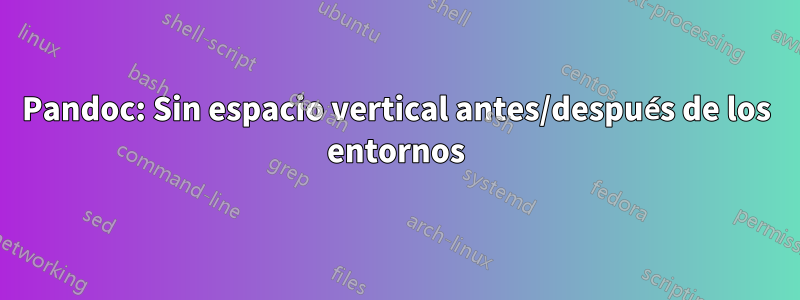
Cuando renderizo un documento pandoc-markdown a PDF que contiene entornos LaTeX, por ejemplo, este
We come now to the main theorem of our article.
\begin{thm}
There exists something that doesn't exist.
\end{thm}
This follows trivially by induction.
entonces no hay espacio vertical entre la línea "Vamos ..." y el entorno del teorema (mientras que se inserta un espacio vertical positivo cuando se renderiza normalmente usando LaTeX).
Aquí, el thmentorno se define como de costumbre (suponiendo que el paquete amsthmesté incluido) por
\newtheorem{thm}{Theorem}
¿Cómo puedo hacer que pandoc inserte espacio vertical alrededor de los entornos (sin tener que insertarlos manualmente)?
Editar:Aquí está el resultado de pandoc -D latex:
\documentclass[$if(fontsize)$$fontsize$,$endif$$if(lang)$$babel-lang$,$endif$$if(papersize)$$papersize$paper,$endif$$for(classoption)$$classoption$$sep$,$endfor$]{$documentclass$}
$if(beamerarticle)$
\usepackage{beamerarticle} % needs to be loaded first
$endif$
$if(fontfamily)$
\usepackage[$for(fontfamilyoptions)$$fontfamilyoptions$$sep$,$endfor$]{$fontfamily$}
$else$
\usepackage{lmodern}
$endif$
$if(linestretch)$
\usepackage{setspace}
\setstretch{$linestretch$}
$endif$
\usepackage{amssymb,amsmath}
\usepackage{ifxetex,ifluatex}
\usepackage{fixltx2e} % provides \textsubscript
\ifnum 0\ifxetex 1\fi\ifluatex 1\fi=0 % if pdftex
\usepackage[$if(fontenc)$$fontenc$$else$T1$endif$]{fontenc}
\usepackage[utf8]{inputenc}
$if(euro)$
\usepackage{eurosym}
$endif$
\else % if luatex or xelatex
\ifxetex
\usepackage{mathspec}
\else
\usepackage{fontspec}
\fi
\defaultfontfeatures{Ligatures=TeX,Scale=MatchLowercase}
$for(fontfamilies)$
\newfontfamily{$fontfamilies.name$}[$fontfamilies.options$]{$fontfamilies.font$}
$endfor$
$if(euro)$
\newcommand{\euro}{€}
$endif$
$if(mainfont)$
\setmainfont[$for(mainfontoptions)$$mainfontoptions$$sep$,$endfor$]{$mainfont$}
$endif$
$if(sansfont)$
\setsansfont[$for(sansfontoptions)$$sansfontoptions$$sep$,$endfor$]{$sansfont$}
$endif$
$if(monofont)$
\setmonofont[Mapping=tex-ansi$if(monofontoptions)$,$for(monofontoptions)$$monofontoptions$$sep$,$endfor$$endif$]{$monofont$}
$endif$
$if(mathfont)$
\setmathfont(Digits,Latin,Greek)[$for(mathfontoptions)$$mathfontoptions$$sep$,$endfor$]{$mathfont$}
$endif$
$if(CJKmainfont)$
\usepackage{xeCJK}
\setCJKmainfont[$for(CJKoptions)$$CJKoptions$$sep$,$endfor$]{$CJKmainfont$}
$endif$
\fi
% use upquote if available, for straight quotes in verbatim environments
\IfFileExists{upquote.sty}{\usepackage{upquote}}{}
% use microtype if available
\IfFileExists{microtype.sty}{%
\usepackage[$for(microtypeoptions)$$microtypeoptions$$sep$,$endfor$]{microtype}
\UseMicrotypeSet[protrusion]{basicmath} % disable protrusion for tt fonts
}{}
\PassOptionsToPackage{hyphens}{url} % url is loaded by hyperref
$if(verbatim-in-note)$
\usepackage{fancyvrb}
$endif$
\usepackage[unicode=true]{hyperref}
$if(colorlinks)$
\PassOptionsToPackage{usenames,dvipsnames}{color} % color is loaded by hyperref
$endif$
\hypersetup{
$if(title-meta)$
pdftitle={$title-meta$},
$endif$
$if(author-meta)$
pdfauthor={$author-meta$},
$endif$
$if(keywords)$
pdfkeywords={$for(keywords)$$keywords$$sep$, $endfor$},
$endif$
$if(colorlinks)$
colorlinks=true,
linkcolor=$if(linkcolor)$$linkcolor$$else$Maroon$endif$,
citecolor=$if(citecolor)$$citecolor$$else$Blue$endif$,
urlcolor=$if(urlcolor)$$urlcolor$$else$Blue$endif$,
$else$
pdfborder={0 0 0},
$endif$
breaklinks=true}
\urlstyle{same} % don't use monospace font for urls
$if(verbatim-in-note)$
\VerbatimFootnotes % allows verbatim text in footnotes
$endif$
$if(geometry)$
\usepackage[$for(geometry)$$geometry$$sep$,$endfor$]{geometry}
$endif$
$if(lang)$
\ifnum 0\ifxetex 1\fi\ifluatex 1\fi=0 % if pdftex
\usepackage[shorthands=off,$for(babel-otherlangs)$$babel-otherlangs$,$endfor$main=$babel-lang$]{babel}
$if(babel-newcommands)$
$babel-newcommands$
$endif$
\else
\usepackage{polyglossia}
\setmainlanguage[$polyglossia-lang.options$]{$polyglossia-lang.name$}
$for(polyglossia-otherlangs)$
\setotherlanguage[$polyglossia-otherlangs.options$]{$polyglossia-otherlangs.name$}
$endfor$
\fi
$endif$
$if(natbib)$
\usepackage{natbib}
\bibliographystyle{$if(biblio-style)$$biblio-style$$else$plainnat$endif$}
$endif$
$if(biblatex)$
\usepackage[$if(biblio-style)$style=$biblio-style$,$endif$$for(biblatexoptions)$$biblatexoptions$$sep$,$endfor$]{biblatex}
$for(bibliography)$
\addbibresource{$bibliography$}
$endfor$
$endif$
$if(listings)$
\usepackage{listings}
$endif$
$if(lhs)$
\lstnewenvironment{code}{\lstset{language=Haskell,basicstyle=\small\ttfamily}}{}
$endif$
$if(highlighting-macros)$
$highlighting-macros$
$endif$
$if(tables)$
\usepackage{longtable,booktabs}
% Fix footnotes in tables (requires footnote package)
\IfFileExists{footnote.sty}{\usepackage{footnote}\makesavenoteenv{long table}}{}
$endif$
$if(graphics)$
\usepackage{graphicx,grffile}
\makeatletter
\def\maxwidth{\ifdim\Gin@nat@width>\linewidth\linewidth\else\Gin@nat@width\fi}
\def\maxheight{\ifdim\Gin@nat@height>\textheight\textheight\else\Gin@nat@height\fi}
\makeatother
% Scale images if necessary, so that they will not overflow the page
% margins by default, and it is still possible to overwrite the defaults
% using explicit options in \includegraphics[width, height, ...]{}
\setkeys{Gin}{width=\maxwidth,height=\maxheight,keepaspectratio}
$endif$
$if(links-as-notes)$
% Make links footnotes instead of hotlinks:
\renewcommand{\href}[2]{#2\footnote{\url{#1}}}
$endif$
$if(strikeout)$
\usepackage[normalem]{ulem}
% avoid problems with \sout in headers with hyperref:
\pdfstringdefDisableCommands{\renewcommand{\sout}{}}
$endif$
$if(indent)$
$else$
\IfFileExists{parskip.sty}{%
\usepackage{parskip}
}{% else
\setlength{\parindent}{0pt}
\setlength{\parskip}{6pt plus 2pt minus 1pt}
}
$endif$
\setlength{\emergencystretch}{3em} % prevent overfull lines
\providecommand{\tightlist}{%
\setlength{\itemsep}{0pt}\setlength{\parskip}{0pt}}
$if(numbersections)$
\setcounter{secnumdepth}{$if(secnumdepth)$$secnumdepth$$else$5$endif$}
$else$
\setcounter{secnumdepth}{0}
$endif$
$if(subparagraph)$
$else$
% Redefines (sub)paragraphs to behave more like sections
\ifx\paragraph\undefined\else
\let\oldparagraph\paragraph
\renewcommand{\paragraph}[1]{\oldparagraph{#1}\mbox{}}
\fi
\ifx\subparagraph\undefined\else
\let\oldsubparagraph\subparagraph
\renewcommand{\subparagraph}[1]{\oldsubparagraph{#1}\mbox{}}
\fi
$endif$
$if(dir)$
\ifxetex
% load bidi as late as possible as it modifies e.g. graphicx
$if(latex-dir-rtl)$
\usepackage[RTLdocument]{bidi}
$else$
\usepackage{bidi}
$endif$
\fi
\ifnum 0\ifxetex 1\fi\ifluatex 1\fi=0 % if pdftex
\TeXXeTstate=1
\newcommand{\RL}[1]{\beginR #1\endR}
\newcommand{\LR}[1]{\beginL #1\endL}
\newenvironment{RTL}{\beginR}{\endR}
\newenvironment{LTR}{\beginL}{\endL}
\fi
$endif$
% set default figure placement to htbp
\makeatletter
\def\fps@figure{htbp}
\makeatother
$for(header-includes)$
$header-includes$
$endfor$
$if(title)$
\title{$title$$if(thanks)$\thanks{$thanks$}$endif$}
$endif$
$if(subtitle)$
\providecommand{\subtitle}[1]{}
\subtitle{$subtitle$}
$endif$
$if(author)$
\author{$for(author)$$author$$sep$ \and $endfor$}
$endif$
$if(institute)$
\providecommand{\institute}[1]{}
\institute{$for(institute)$$institute$$sep$ \and $endfor$}
$endif$
\date{$date$}
\begin{document}
$if(title)$
\maketitle
$endif$
$if(abstract)$
\begin{abstract}
$abstract$
\end{abstract}
$endif$
$for(include-before)$
$include-before$
$endfor$
$if(toc)$
{
$if(colorlinks)$
\hypersetup{linkcolor=$if(toccolor)$$toccolor$$else$black$endif$}
$endif$
\setcounter{tocdepth}{$toc-depth$}
\tableofcontents
}
$endif$
$if(lot)$
\listoftables
$endif$
$if(lof)$
\listoffigures
$endif$
$body$
$if(natbib)$
$if(bibliography)$
$if(biblio-title)$
$if(book-class)$
\renewcommand\bibname{$biblio-title$}
$else$
\renewcommand\refname{$biblio-title$}
$endif$
$endif$
\bibliography{$for(bibliography)$$bibliography$$sep$,$endfor$}
$endif$
$endif$
$if(biblatex)$
\printbibliography$if(biblio-title)$[title=$biblio-title$]$endif$
$endif$
$for(include-after)$
$include-after$
$endfor$
\end{document}
Respuesta1
Asegúrese de agregar el entorno del teorema header-includesy utilizar la plantilla predeterminada. En esa situación, se renderizará normalmente, con espacio vertical antes y después:
pandoc -o thm.pdf << EOT
---
header-includes:
- \usepackage{amsthm}
- \newtheorem{thm}{Theorem}
---
We come now to the main theorem of our article.
\begin{thm}
There exists something that doesn't exist.
\end{thm}
This follows trivially by induction.
EOT
Respuesta2
La causa del problema:Al final resultó que, el culpable fue la inclusión del parskippaquete en la plantilla LaTeX predeterminada, aquí mismo:
$if(indent)$
$else$
\IfFileExists{parskip.sty}{%
\usepackage{parskip}
}{% else
\setlength{\parindent}{0pt}
\setlength{\parskip}{6pt plus 2pt minus 1pt}
}
$endif$
Aunque en teoría (cf.esta respuesta) el paquete parskip no debería hacer nada más que configurar \parskipy \paridentparece estropear seriamente las cosas.
Solución(es):Hay al menos dos formas de solucionar este problema:
Establecer la
indentvariable:pandoc --variable=indent -o file.pdf file.mdUtilice una plantilla personalizada: primero exporte la plantilla predeterminada
pandoc -D latex > template.texLuego elimine la sección problemática de la plantilla mencionada anteriormente.
vim template.texFinalmente, use
template.texen lugar de la plantilla predeterminada:pandoc --template=template.tex -o file.pdf file.md



